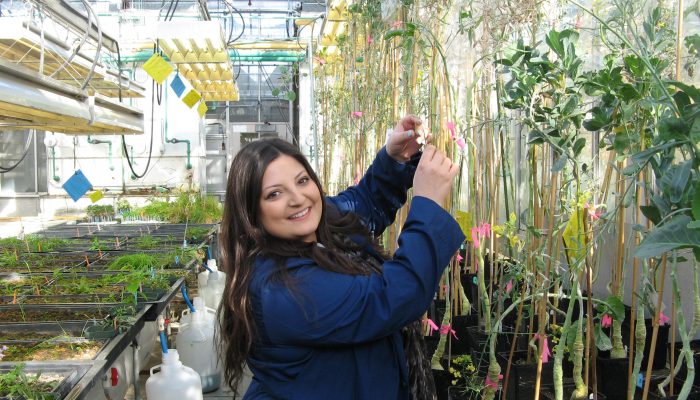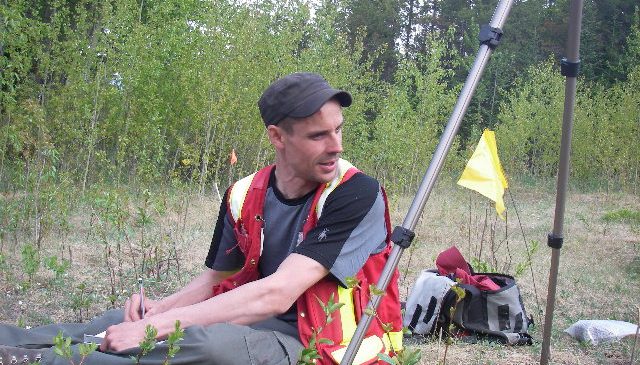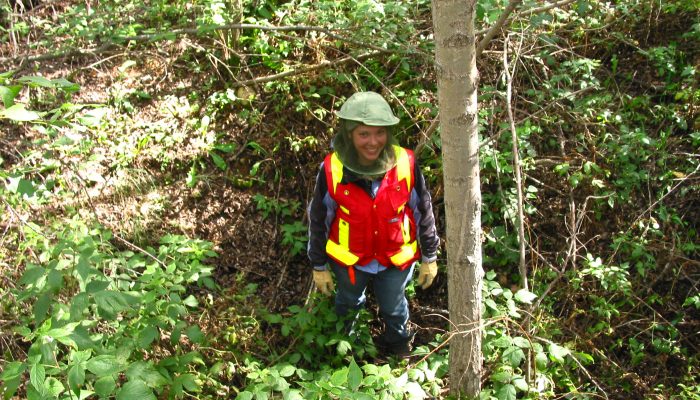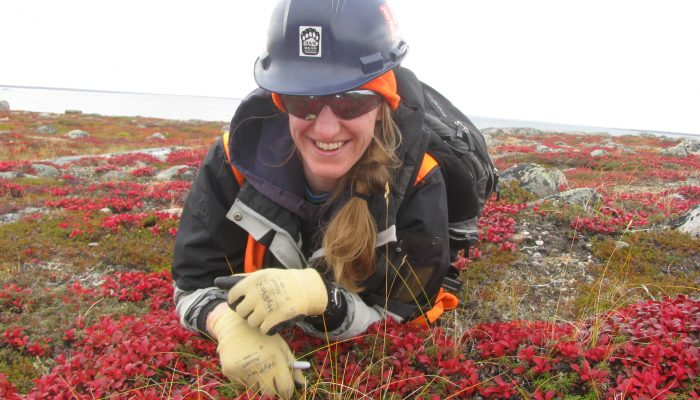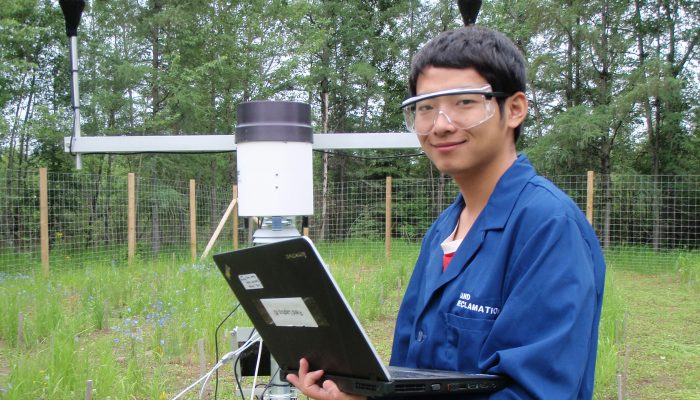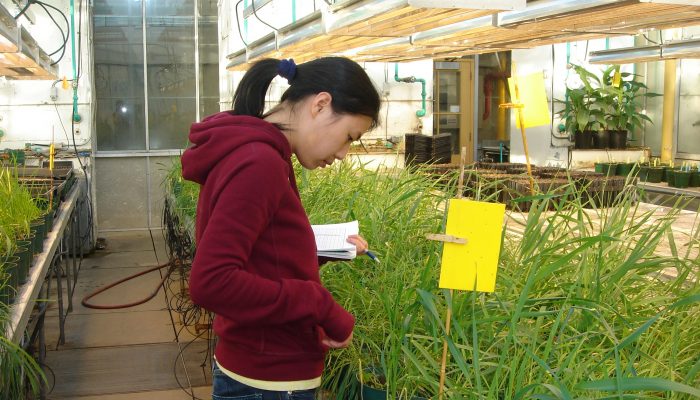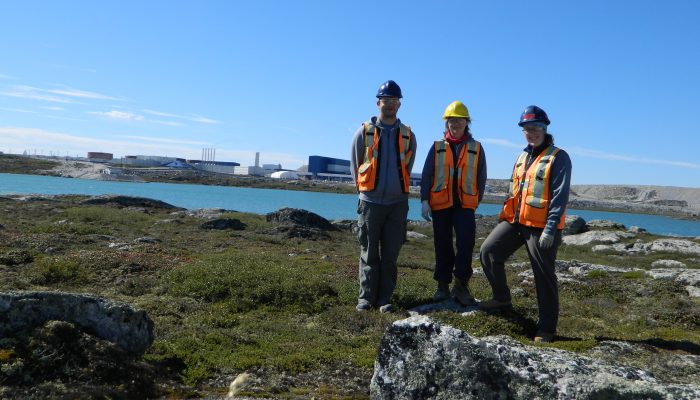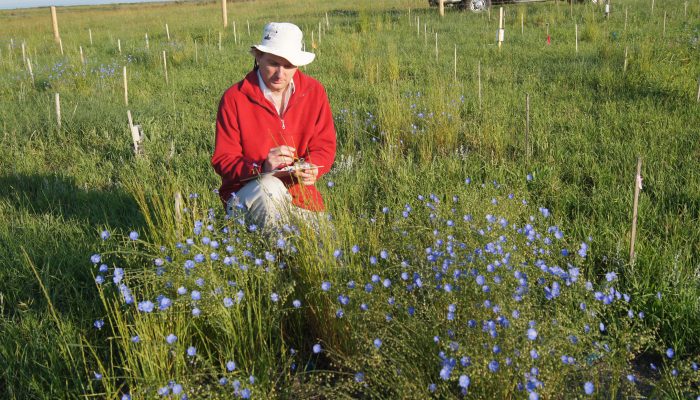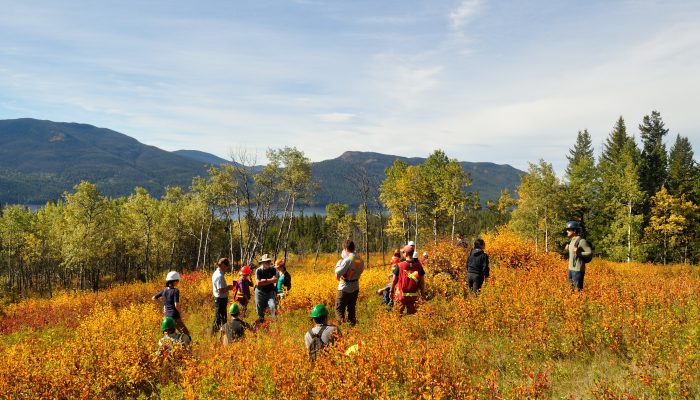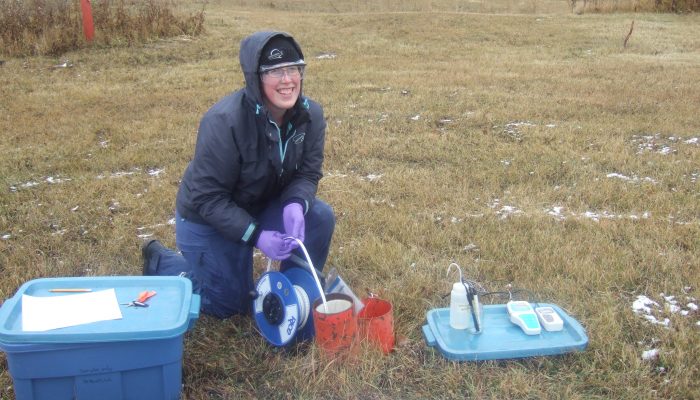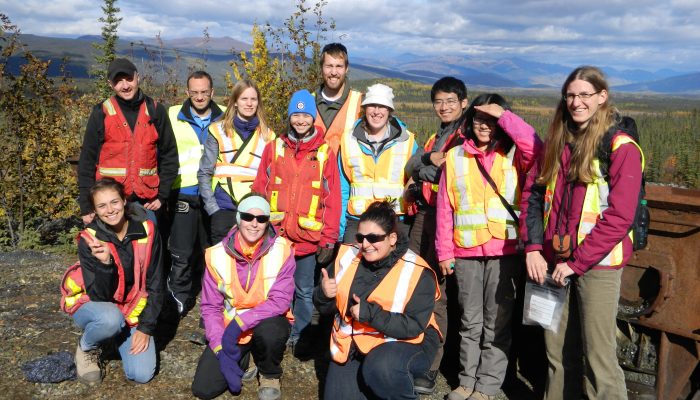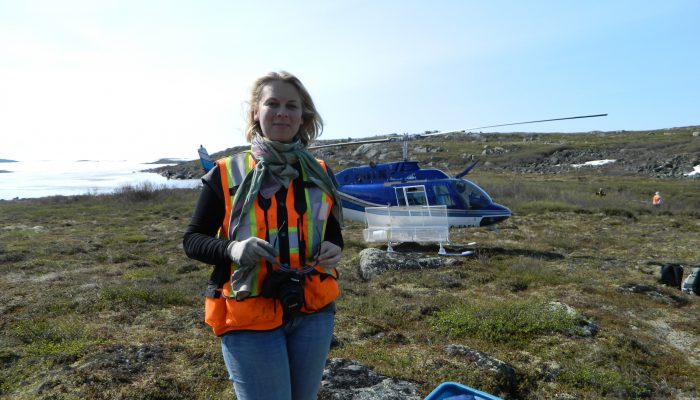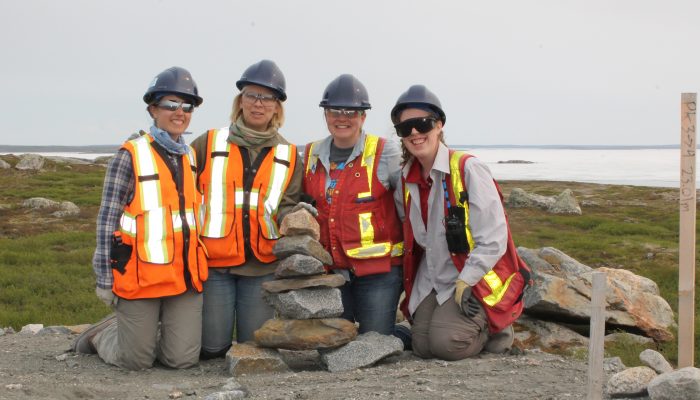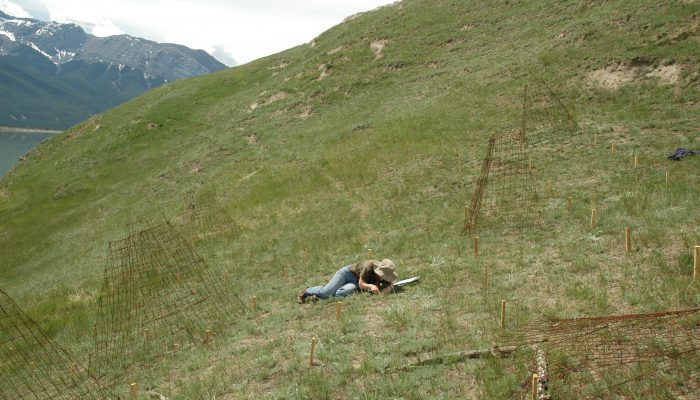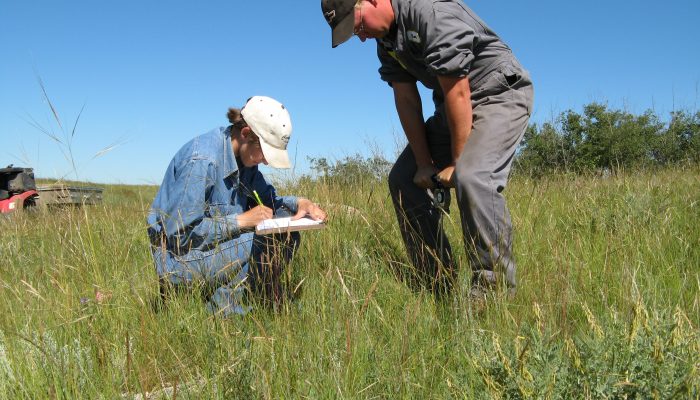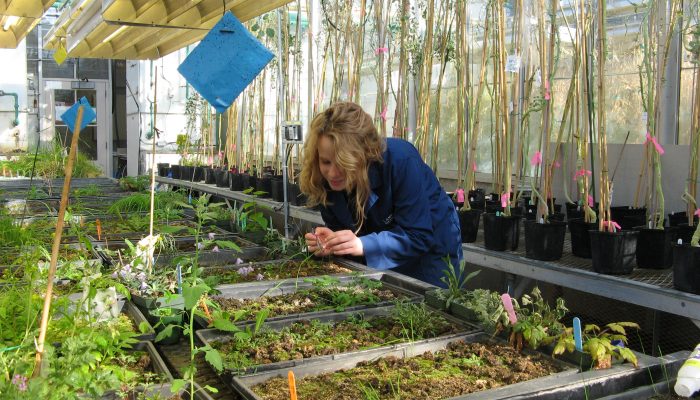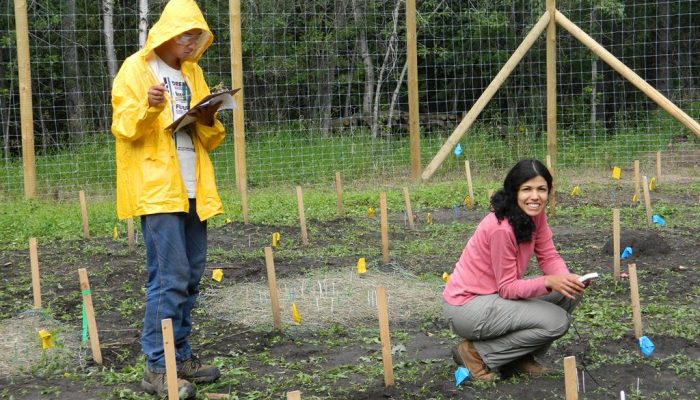 Abhijeet Pathy, PhD Candidate
Abhijeet Pathy, PhD Candidate
Remediating Industry Affected Process Water And Soil And Ground Water Using Biochar
Biochar is an effective method for removing heavy metals in contaminated water and soil through adsorption. This research aims to optimize biochar's effectiveness in remediating contaminants in oil sands process water and soil and ground water near pipelines.
 Megan MacElheren, MSc Candidate
Megan MacElheren, MSc Candidate
Seasonal And Microsite Variability Of Soil Microbiological Properties
The growing human population requires increased agricultural production and sustainable land management practices. Microbiological indicators of soil health are considered a rapid and reliable method for monitoring effects of land management practices on soil properties. Although seasonal and microsite variability in soil microbiological properties has not been examined in legume-grass stands in Alberta, it could be useful in determining best sampling practices to monitor grassland soil health.
 Lindsay Van Damme, MSc Course Based
Lindsay Van Damme, MSc Course Based
Conservation And Restoration Of Land And Water
 Irum Zahara, PhD
Coal Derived Humic Products For Metal Remediation From Wastewater
Water pollution containing heavy metals has now become a global concern. Although these metals have nutritional requirements, they can be toxic to living organisms if consumed beyond their permissible limits. These metals are non-biodegradable and resistant to depletion; therefore, treatment technologies are required for their removal from wastewater. This research aims to utilize the coal derived humic products as adsorbents for removal of multi-metals (divalent cations and oxyanions) from industrial wastewater.
Irum Zahara, PhD
Coal Derived Humic Products For Metal Remediation From Wastewater
Water pollution containing heavy metals has now become a global concern. Although these metals have nutritional requirements, they can be toxic to living organisms if consumed beyond their permissible limits. These metals are non-biodegradable and resistant to depletion; therefore, treatment technologies are required for their removal from wastewater. This research aims to utilize the coal derived humic products as adsorbents for removal of multi-metals (divalent cations and oxyanions) from industrial wastewater.
 Sarah Wilkinson, MSc
Sarah Wilkinson, MSc
Research Program Manager
Sarah is Research Program Manager for Dr Naeth. She oversees day to day administration of the research program; provides technical and logistical support for research projects conducted by Dr Naeth, her post-docs and graduate students; trains and supervises research assistants; and manages the reclamation research laboratories. She conducts research, data analyses and prepares papers for publication. Sarah is Co-Coordinator of the Future Energy Systems’ Resilient Reclaimed Land and Water Systems theme.

Stacy Campbell Court, BSc
Administration and Research Assistant
Stacy provides administrative support for Dr Naeth's research, teaching and administration activities. Stacy coordinates meetings and travel, formats documents and papers for publication, maintains research and office equipment and space, processes expense claims, edits web content for Dr Naeth and the Land Reclamation International Graduate School and performs a variety of other tasks as needed.
 Amalesh Dhar, PhD
Amalesh Dhar, PhD
Research Associate
Amalesh works with Dr Naeth on several reclamation and restoration research projects. He obtained his PhD degree from University of Natural Resources and Life Sciences, Vienna, Austria and has over nine years of research experience in various fields of natural resources management at University of British Columbia, University of Northern British Columbia and Bulkley Valley Research Centre. His areas of expertise are reclamation and restoration ecology, landscape disturbances, ecosystem health and biodiversity, climate change and forest ecology and management.
 David Chanasyk, PhD
David Chanasyk, PhD
David is a professor emeritus at the University of Alberta in the Department of Renewable Resources. His research expertise includes rural water quality, agricultural impacts on hydrologic processes, impacts of post-mine disturbances on hydrologic components and land reclamation.
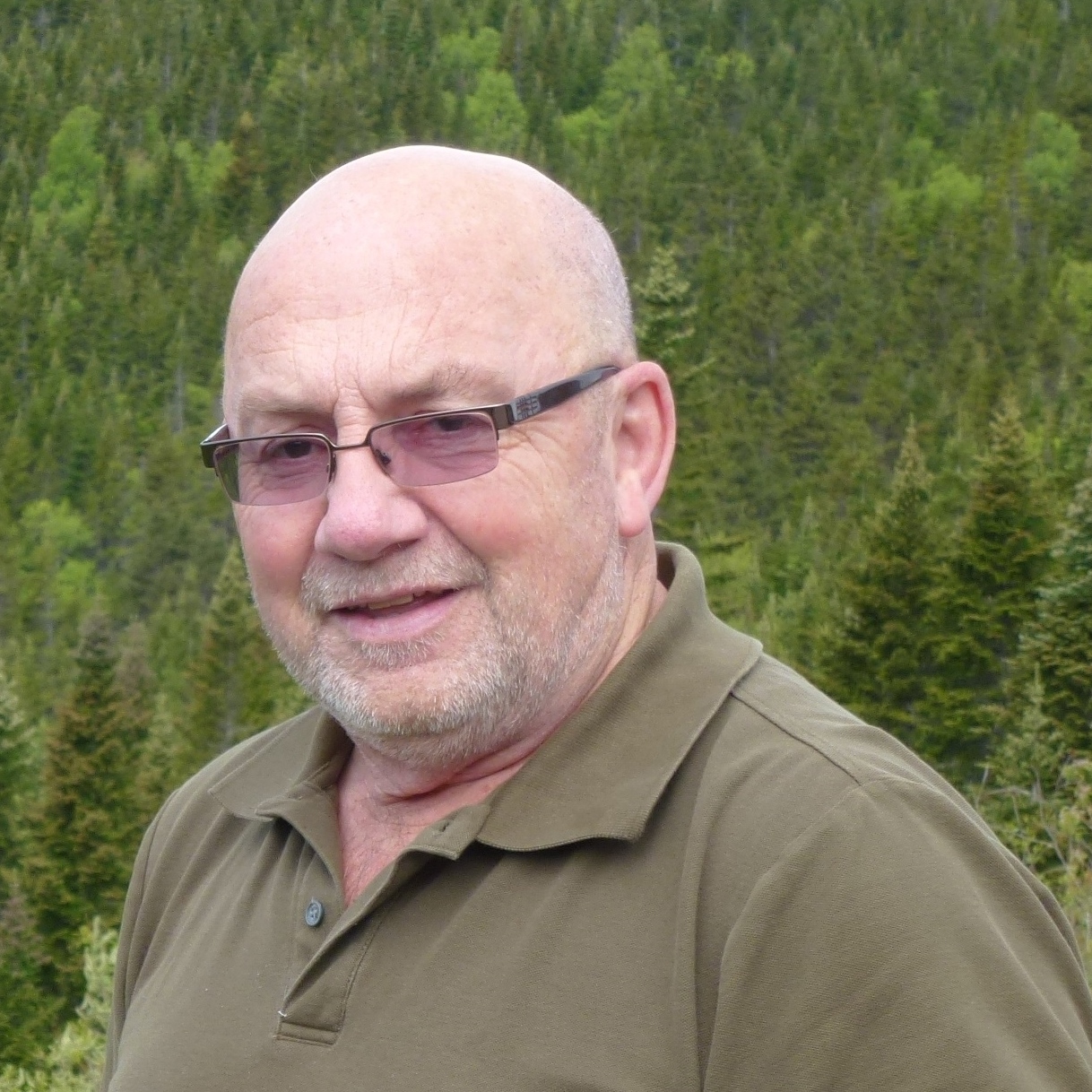 Allen Jobson, PhD
Allen Jobson, PhD
Al has worked for Alberta Environment, various consulting companies and Ostrem chemicals and is a former adjunct professor at the University of Alberta. His research expertise is in microbiology and contaminant remediation, especially bioremediation.
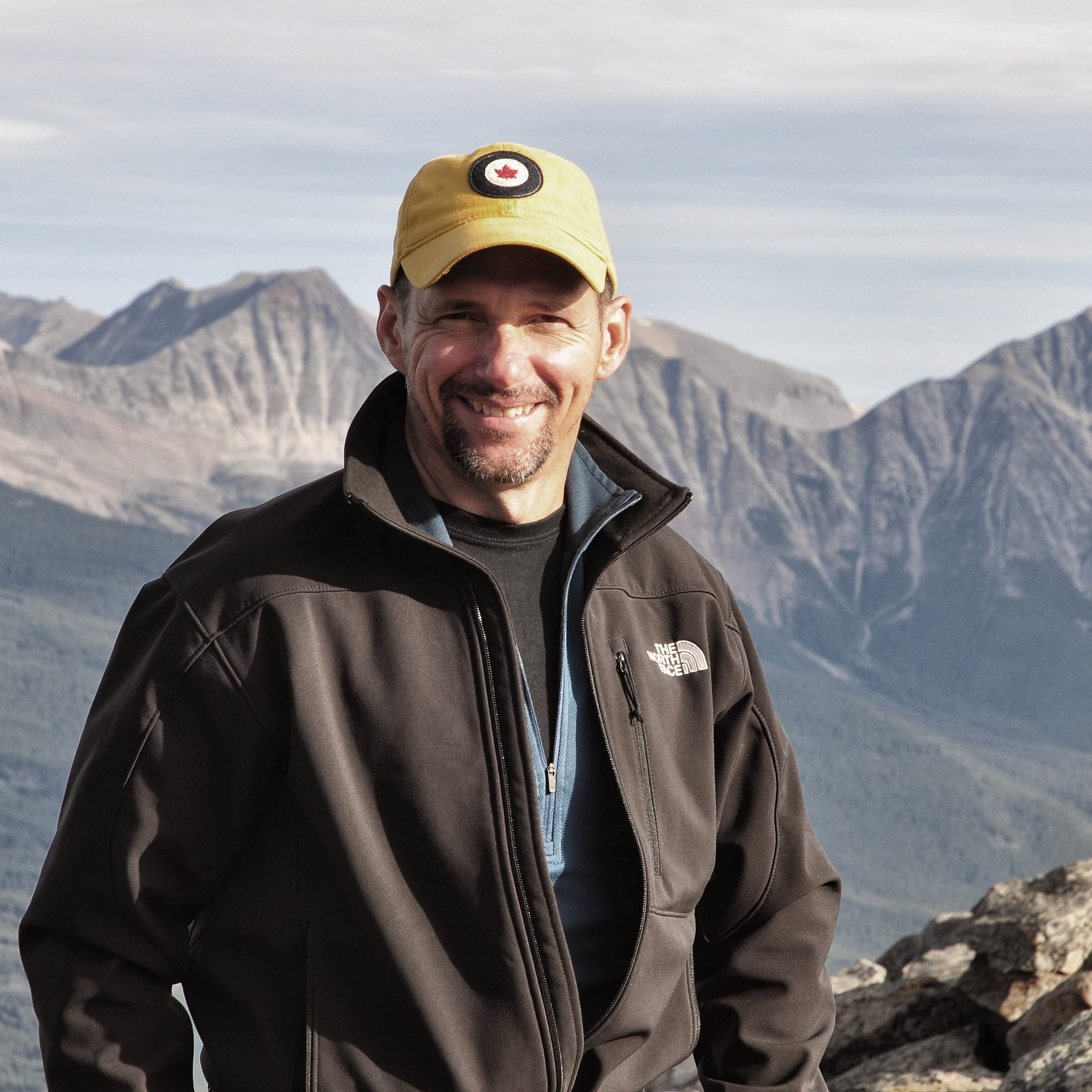 David Locky, PhD
David Locky, PhD
David is an assistant professor in Biological Sciences at MacEwan University and an adjunct professor at the University of Alberta. As a professional wetland biologist and professional biologist, he has a broad range of research interests in wetland classification; plant rarity, diversity and biogeography; natural and human impacts on wetlands and wetland policy and practices.
 Shelley Pruss, PhD
Shelley Pruss, PhD
Shelley is a conservation specialist with Parks Canada and an adjunct professor at the University of Alberta. Shelley has published on many species at risk in Canada including the swift fox, Morman metalmark butterfly, greater sage grouse and the greater short horned lizard.
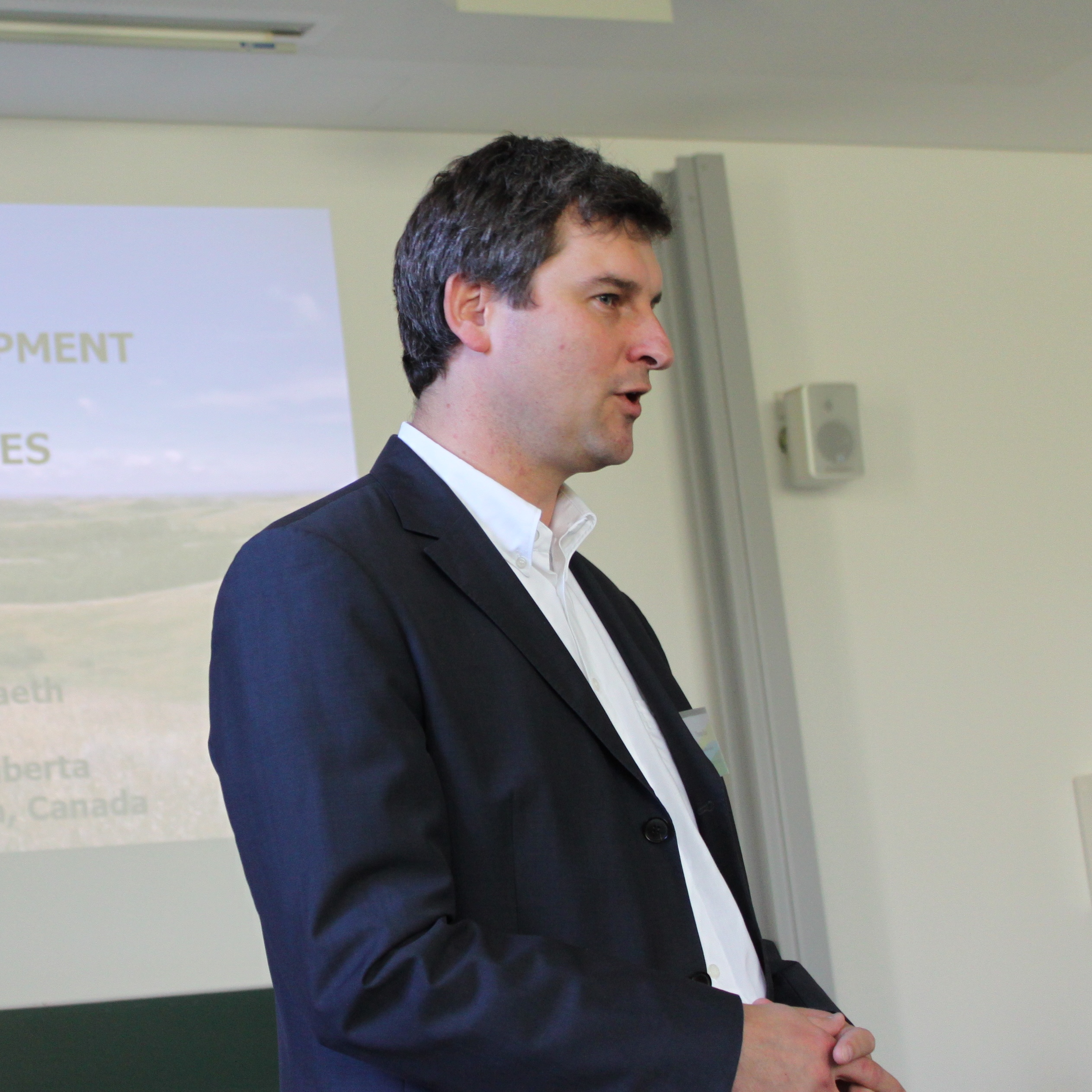 Thomas Raab, PhD
Thomas Raab, PhD
Thomas is the chair of Geopedology and Landscape Development at the Brandenburg University of Technology in Cottbus, Germany. His research interests are soil development, human induced landscape change, environmental impact of historic and prehistoric mining, glacial geology and geomorphology and soil and sediments as archives of landscape development.
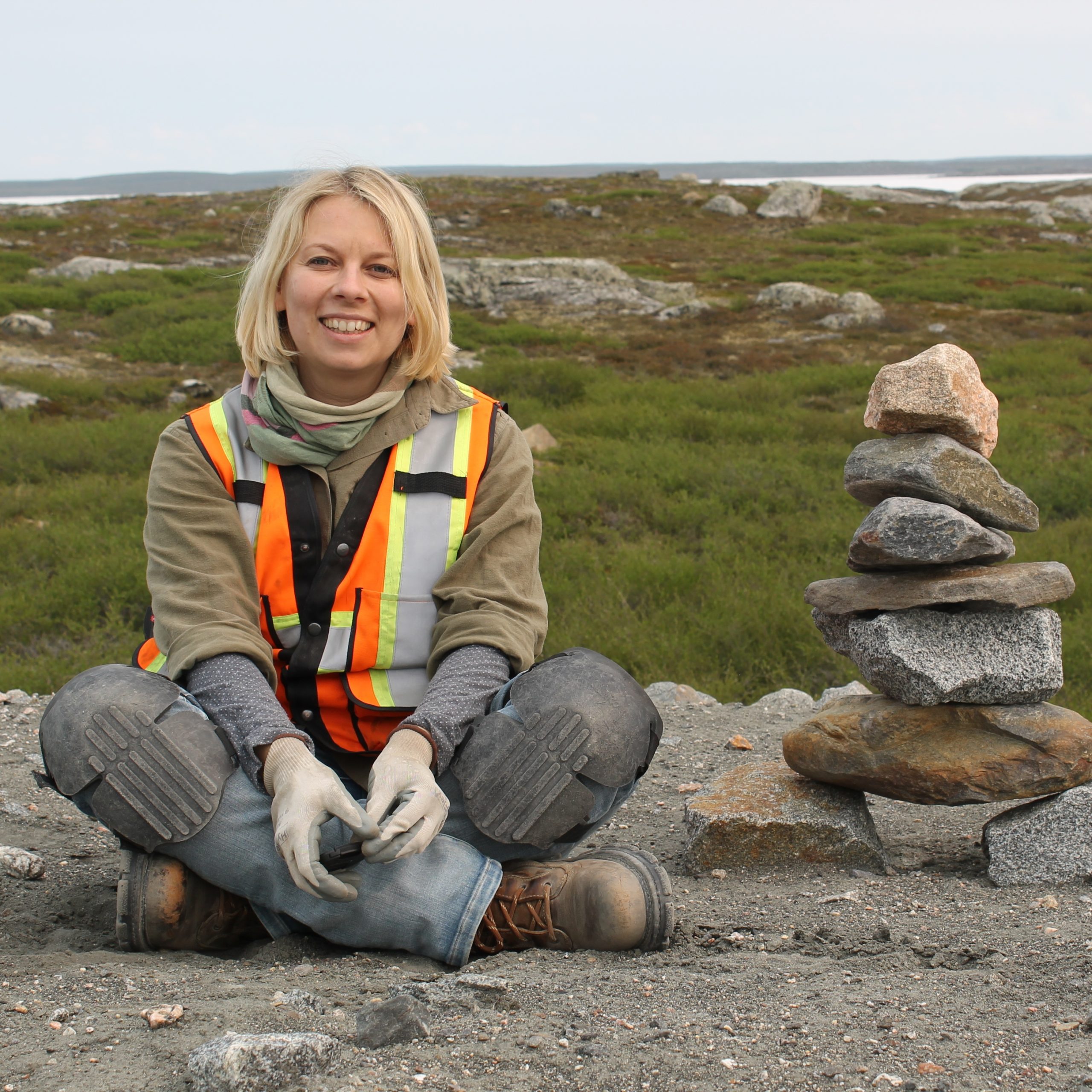 Katja Boldt-Burisch, PhD
Katja Boldt-Burisch, PhD
Katja is a scientist at the Brandenburg University of Technology in Cottbus, Germany and a referee for mycology/bacteriology at the State Office for Rural Development, Agriculture and Land Reconciliation in Germany. She completed her post-doctoral fellowship under the co-supervision of Dr Naeth. Katja’s research interests include root ecology and arbuscular mycorrhizal fungi development during land reclamation.
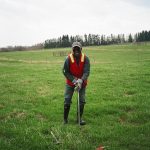 Emmanuel Mapfumo, PhD
Emmanuel Mapfumo, PhD
Emmanuel is a professor of Environmental Science at Concordia University, and the Program Coordinator for Environmental Science in the Department of Environmental and Physical Sciences. Emmanuel's research interests include land reclamation, remediation and the impact of climate change on agricultural systems.
 Dean MacKenzie, PhD
Dean MacKenzie, PhD
Dean is the Vice President, Environment, at Vertex Resources Group Ltd. His research interests include conservation and land reclamation, revegetation, remote sensing, soil classification and biodiversity. He has worked with key industries in Alberta, coal mining, oil sands mining, oil and gas, aggregate and renewable energy. Dean earned his PhD from the University of Alberta in 2013.
Muhammad Arslan, PhD
Dr Arslan's research looked into the molecular microbial ecology of oil sands process water, to clarify rates of genomic evolution and organismal adaptation. This research may help develop an improved bioremediation system through augmentation.
Katja Boldt-Burisch, PhD
Dr Katja Boldt-Burisch’s research focused on arbuscular mycorrhizal fungi development under herbaceous plant growth and different reclamation substrates providing information about how developmental stages of a reclamation area influences mycorrhizal community composition and abundance.
Maryam Firoozbakht, PhD
Dr Firoozbakht's research examined the function and dynamics of microbial communities in peatlands that have been impacted by hydrocarbons. This research can be used to develop effective bioremediation strategies to reduce environmental pollution and restore the health of these ecosystems.
Stephanie Chute Ibsen, PhD
Dr Ibsen's post doctoral research investigated the biophysical indicators of high elevation grassland reclamation success post coal mining.
Anayansi Cohen-Fernández, PhD
Dr Cohen-Fernandez’s research on micro sites increased understanding of fine scale environmental heterogeneity effects on establishment of target plant communities and early ecosystem development through physical, chemical and biological attributes of constructed microsites.
Jinhyeob Kwak, PhD
Dr Kwak’s research focused on long-term coarse woody debris effects on biogeochemistry in reconstructed soils in the Athabasca oil sands and the optimization of biochar for reclamation of oil sands process water.
Emmanuel Mapfumo, PhD
Dr Mapfumo's primary research investigated changes in physical and chemical properties in soils under various grazing and crop systems in the grassland and parkland regions of Alberta, particularly focused on modelling soil water dynamics and soil compaction.
Federico Mollard, PhD
Dr Mollard’s research focused on improving reclamation success with native plant species in a twofold study. One addressed light, temperature and hydrologic triggers for germination of native plant species and another addressed the effect of hay amendment on native grass emergence and establishment after broadcast seeding.
Linjun (Marteya) Yao, PhD
Dr Yao’s research addressed improvement of soil properties such as water holding capacity, nutrients, electrical conductivity, pH and temperature to create substrates suitable for plant establishment and growth, leading to enhanced understanding of disturbed ecosystem processes.
Yihan Zhao, PhD
Dr Zhao's field and greenhouse research assessed the potential of using mineral source derived material as amendments to address soil deterioration issue in coal mine sites and to return the disturbed land to a productive, sustainable and beneficial state.
PhD Graduate Student Dissertations
Ibsen, S.M. 2024. Soil invertebrate indicators of land reclamation success.
Ficko, S.A. 2022. Development of shrub and lichen-dominated biocrust propagation and establishment techniques for reclamation in northern environments.
Zhao, Y. 2022. Humic substances as soil amendments in coal mine reclamation.
Watkinson, A.D. 2020. Restoration of sagebrush grassland for greater sage grouse habitat in Grasslands National Park, Saskatchewan.
Murata, A.P. 2019. Long term dynamics and potential remediation of fine textured soils and ground water contaminated with chlorinated organic compounds and salts.
Miller, V.S. 2019. Development of soils for revegetation in northern diamond mines.
Jamro, G.M. 2016. Soil biogeochemical processes and fine root dynamics of vegetation in LFH mineral soil mix and peat mineral soil mix organic capping materials used for oil sands reclamation.
Kwak, J. 2015. Coarse woody debris effects on biogeochemistry in two reconstructed soils in the Athabasca oil sands region in Alberta, Canada.
Yao, L. 2013. Potassium silicate drilling fluid as a land reclamation amendment.
MacKenzie, D.D. 2012. Oil sand mine reclamation using boreal forest surface soil (LFH) in northern Alberta.
Cohen-Fernández, A.C. 2012. Reclamation of a limestone quarry to a natural plant community.
Desserud, P.A. 2011. Rough fescue (Festuca hallii) ecology and restoration in central Alberta.
Henderson, D.C. 2005. Ecology and management of crested wheatgrass invasion.
Gardner, W.C. 2004. Copper mine tailings reclamation with biosolids.
Hammermeister, A.M. 2001. An ecological analysis of prairie rehabilitation on petroleum wellsites in southeast Alberta.
MSc Graduate Student Theses
Safaripour-Chafi, M. 2025. Phytoremediation potential of seven native plant species for hydrocarbon contaminated peat soils.
Stark, B. 2023. Course based Masters of Agriculture in Land and Water Resources.
Bony, L. 2020. Salt affected soils and their relationships with plant communities on reclamation well sites.
Robinson, M.J.C. 2018. Phosphogypsum reclamation: evaluating alternative and traditional cover systems.
Zhao, Y. 2017. Biomonitoring and assessment of airborne fluoride from fertilizer production.
Frerichs, L.A. 2017. Decadal assessment of successional development on reclaimed upland boreal well sites.
Low, C.H. 2016. Impacts of a six year old pipeline right of way on Halimolobos virgata (Nutt.) O.E. Schulz (slender mouse ear cress), native dry mixedgrass prairie uplands, and wetlands.
Lamarre, J.J.M. 2016. Tundra bryophyte revegetation: novel methods for revegetating northern ecosystems.
Aguilar Rojas, J. 2016. Urban naturalization for green spaces in the City of Edmonton, Alberta, Canada.
AbouRizk, J.S. 2015. Potential anthroposol development using phosphogypsum as a substrate with soil and organic amendments.
Jiao. Z. 2015. Effects of mirco sites and amendments on near surface soil temperature and volumetric water content to enhance revegetation.
Forsch, K.B.C. 2014. Oil sands reclamation using woody debris with LFH mineral soil mix and peat mineral soil mix cover soils: impacts on select soil and vegetation properties.
Nannt, M.R. 2014. Impacts of distance to pipeline disturbance on mixed grass prairie and Halimolobos virgata (Nutt.) O.E. Schulz (slender mouse ear cress).
Archibald, H.A. 2013. Early ecosystem genesis using LFH and peat peat amendments on Athabasca oil sands reclamation.
Stover, H.J. 2013. Non-native plant management and restoration of foothills fescue grassland in Waterton Lakes National Park, Alberta.
Turner, E.L. 2012. Influence of soil cap depth and vegetation on reclamation of phosphogypsum stacks in Fort Saskatchewan, Alberta.
Luna Wolter, G.L. 2012. Development of reclamation substrates for Alberta oil sands using mature fine tailings and coke.
Sherritt, D.E. 2012. Festuca hallii (Vasey) Piper (plains rough fescue) and Festuca campestris Rydb (foothills rough fescue) response to seed mix diversity and mycorrhizae.
Steinke, L.A. 2011. Plant and soil biophysical properties for evaluating land reclamation in Jasper National Park.
Nemirsky, C.L. 2011. Prairie plant species at risk in southern Alberta: identification of critical habitat at the microsite level for Halimolobos virgata (Nutt.) O.E. Schulz and determination of set back distance between pipeline disturbance and Halimolobos virgata and Cryptantha minima Rydb.
Brown, R.L. 2010. Use of woody debris as an amendment for soil reclamation after oil sands mining.
Cartier, S.B. 2010. Early stages of calcareous soil reclamation along the TMX Anchor Loop pipeline in Jasper National Park.
Shaughnessy, B.E. 2010. Natural recovery of upland boreal forest vegetation on a hummocky peat-mineral mix substrate in the Athabasca oil sands region, Alberta.
Antill, T.M. 2009. Biology and control of Russian thistle (Salsola tragus L.) in bighorn sheep (Ovis canadensis Shaw) winter ranges in montane grasslands of Jasper National Park, Alberta.
Elsinger, M.E. 2009. Reclamation status of plains rough fescue grasslands at Rumsey Block in Central Alberta, Canada after oil and gas well site and pipeline disturbances.
Hallin, I.L. 2009. Evaluation of a substrate and vegetation cover system for reclaimed phosphogypsum stacks at Fort Saskatchewan, Alberta.
Jackson, M.E. 2009. Assessment of soil capping for phosphogypsum stack reclamation at Fort Saskatchewan, Alberta.
Stanton-Kennedy, T.S. 2008. Soil and vegetation change on a coal mine 15 years after reclamation in the aspen parkland of Alberta.
Kwiatkowski, B.L. 2007. Diamond mine reclamation in the NWT: substrates, soil amendments and native plant community development.
Mackenzie, D.D. 2006. Assisted natural recovery using a forest soil propagule bank in the Athabasca oil sands, region.
Burgers, T.D. 2005. Reclamation of an oil sands tailings storage facility: vegetation and soil interactions.
Graham, S.C. 2005. Reclamation of hydrocarbon contaminated soils in Central Alberta using compost, fertilizer and native species.
Heidman, A.P. 2005. Bioremediation of hydrocarbon contaminated and compost amended soil: effects on microbial communities in the field.
Johnson, D.J. 2005. Pulp mill effluent irrigation for forage production.
Parker, E.A. 2005. Bromus inermis Leyss. persistence and invasion in Alberta aspen parkland.
Salisbury, B.S. 2004. Natural recovery versus seeding on a pipeline right-of-way in a boreal mixedwood forest in central Alberta.
Wruck, G.W. 2004. Revegetation and spatial patterns in pipeline reclamation in sandhills of Alberta's aspen parkland.
Smith, R.S. 2004. Water quality indicators for cumulative environmental effects assessment in the Bow and Red Deer River basins, Alberta, Canada.
Van Bostelen, C.J. 2003. Ungulate habitat restoration in Elk Island National Park.
Reid, N.B. 2002. Establishment of a vegetation cover on kimberlite mine tailings.
McIntryre, N.A. 2002. Reclamation of diesel fuel contaminated sites in northern Alberta.
Wilkinson, S.R. 2002. Management of elephant grass and restoration of moist evergreen forest in abandoned pastures, Galapagos Islands, Ecuador.
Bottorff, Q.W. 2001. Fire skips and understory plant diversity in an upper foothills-subalpine forest in northwestern Alberta.
Erichsen Arychuk, C.J. 2001. Native forb establishment on disturbed sites in the aspen parkland.
Ostermann, D.K. 2001. Revegetation assessment of a twelve year old pipeline on native rangeland in southern Alberta.
Soloudre, E.M.J. 2001. Restoration ecology of cattle grazing on mixed prairie well sites: a hierarchical approach.
Henderson, D.C. 2000. Carbon storage in grazed prairie grasslands of Alberta.
Mathison, M.M. 2000. Longevity of deep ripping effects on solonetzic soils.
Petherbridge, W.L. 2000. Sod salvage and minimal disturbance pipeline reclamation techniques: implications for native prairie restoration.
Pitchford, C.L. 2000. Season of seeding, mowing and seed mix richness for native plant community development in the aspen parkland.
Genoway, P.T. 1999. Suckering potential of declining aspen stands and mixedwood stands in west-central Saskatchewan.
Moskal, T.D. 1999. Moisture characteristics of coarse textured soils and peat:mineral mixes.
Schaefer, J.W. 1999. Bioengineering and reclamation to stabilize a lakeshore slope.
Banks, T.R. 1998. Effects of land use changes on trumpeter swan (Cygnus buccinator) use of lakes in the Grande Prairie region of Alberta.
Bush, C.D. 1998. Native seed mixes for diverse plant communities.
Fluker, M.G. 1998. Growth response of select native and introduced plant species to soil nutrient levels and interspecific competition.
Howat, D.R. 1998. Enhancing biodiversity on reclaimed lands.
Lamb, T.J. 1998. A study of plant community structure and a reclamation evaluation of disturbed subalpine sites in Glacier National Park, British Columbia.
Brown, D.J. 1997. Smooth brome (Bromus inermis Leyss.) in foothills fescue grassland: stand characterization and the effects of cattle, sheep, mowing, glyphosate and fire.
Gill, S.I. 1997. Grazing effects on runoff and erosion in annual and perennial pastures in the parkland ecoregion of Alberta.
Pelech, W.E. 1997. Performance of selected native and introduced plant species under mowing and herbicide management during the establishment period.
Sansom, J.J. 1996. In situ amelioration of sodic minespoil using sulfur, gypsum and crop management.
Dell, M.W. 1995. Select vegetation characteristics and soil physical properties of different aged russian wildrye pastures.
Hammermeister, A.M. 1995. Soil and plant response to the field application of fly ash.
Sale, L.Y. 1995. Use of unweathered fly ash to improve select soil physical properties and barley growth and development.

